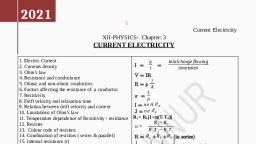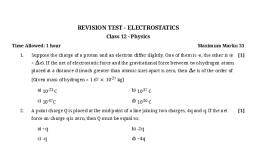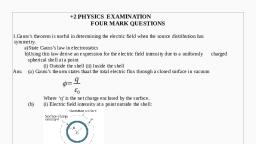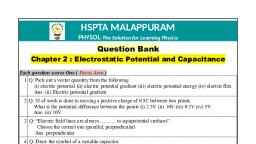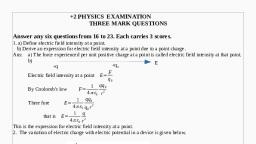Page 2 :
Electrostatic Potential and Potential difference, Electrostatic potential at a point is the work done in bringing a unit positive charge, (without acceleration) from infinity to that point in an electric field., , Work done, Electrostatic potential=, charge, , V=, , W, q, , It is a scalar quantity. Unit is J C-1 or V (Volt), , Potential difference between two points in an electric field is the work, done in moving a unit positive charge from one point to the other, , W BA, Potentail difference ,V A −V B =, q
Page 3 :
Electrostatic potential Energy - It is the energy possessed by a charge by, virtue of its position in an electrostatic field., It is the work done in bringing the charge from infinity to that point in the field., , Electrostatic Potential Energy= Potential x Charge, , U =Vq, The work done to move a charge q from one point to the other is the, change in potential energy of the charge, , W BA =U A −U B =(V A −V B )q
Page 4 :
Relation between Electric field and Potential, A, , +Q, , B, , E, , dr, , Potential difference between, two points is the work done to, move unit positive charge, (+1C) from one point to the, other point., , Force (F) acting on +1C charge placed at the point B = E (electric field), Work done to move +1C charge from B to A,, , dW =F ext dr, , dW =−Edr, (Fext is opposite to electrostatic force E ), So Potential difference (VA – VB),, , E=−, , dV, dr, , dV =−E dr, , Potential V (r )=−∫ E dr, , i.e Electric field is negative gradient of potential., Along the direction of field potential decreases
Page 5 :
Electrostatic Potential due to a point Charge, It is defined as the work done to bring unit positive charge (+1C) from infinity to, that point., From figure, Force acting on +1C placed at B is given by, , So the work done to displace it from B to A, , F=, , 1 Q, 4 π ϵ0 x 2, , dW =−Fdx=, , −1 Q, dx, 4 π ϵ0 x 2, , r, P, , +Q, , A, , dx, , B, , infinity, , x, So total work done to displace from infinity to r is given by, r, , 1 Q, 1 Q, W =−∫, dx=, 2, 4 π ϵ0 r, ∞ 4 π ϵ0 x, , Therefore, , V=, , 1 Q, 4 π ϵ0 r
Page 6 :
Potential Difference between two points - for point charge, Potential difference between two points is the work done to bring a unit, positive charge from one point to the other, r1, , A, , +Q, , B, , r2, Potential at A,, , Potential at B,, , V A=, , V B=, , 1 Q, 4 π ϵ0 r 1, , 1 Q, 4 π ϵ0 r 2, , Potential Difference (P.D), , V A −V B =, , Here VA > VB, since r1 < r2, , Q, 1 1, ( − ), 4 π ϵ0 r 1 r 2, , Along the direction of Electric field potential decreases
Page 7 :
Potential due to a system of Point Charges, Potential at a point due to a system of point charges is the algebraic sum of, potential due to each charge, Potential at P due to each, charge is given by, , 1 q1, V 1=, 4 π ϵ0 r 1 p, , V 2=, , 1 q2, 4 π ϵ0 r 2 p, , 1 q3, V 3=, 4 π ϵ0 r 3 p, So total potential at P, , q1 q2 q3, qn, 1, V =V 1 +V 2 +V 3 +....+V n =, (, +, +, +....+ ), 4 π ϵ0 r 1 p r 2 p r 3 p, r np
Page 8 :
Potential due to an electric dipole, , Potential at P due to +q charge, , V 1=, , 1 q, 4 π ϵ0 r 1, , Potential at P due to -q charge, , V 2=, , −1 q, 4 π ϵ0 r 2, , So Total potential at P due to the dipole, , V =V 1 +V 2=, From figure we can show that, , q, 1 1, ( − ), 4 π ϵ0 r 1 r 2, , 1 1 2 a cos θ, − =, r1 r2, r2, , q 2 a cos θ, 1 p cos θ, V=, =, 4 π ϵ0, 4 π ϵ0 r 2, r2, , Where p = 2a q is, dipole moment
Page 9 :
So Potential due to an electric dipole, , 1 p cos θ, V=, 4 π ϵ0 r 2, , Or, , 1 ⃗p . r^, V=, 4 π ϵ0 r 2, , At a point on axial line θ = 00 or 1800, , V axial =±, , 1 p, 4 π ϵ0 r 2, , At a point on the bisector θ = 900, , V bisector =0, Problems
Page 10 :
Potential due to a spherical shell, Electric field at a distance r from the centre of a spherical shell of radius R and, charge q is given by, 1 q, R, , E=, , 4 π ϵ0 r 2, , This is similar to the field due a point charge. So a spherical charge, distribution can be taken as equivalent to a point charge, So Potential due to a spherical shell (r > R) is given by, , Potential on the surface of the shell, , V=, , V=, , 1 q, 4 π ϵ0 r, , 1 q, 4 π ϵ0 R, , Inside the spherical shell Electric field is zero. So the potential inside the, shell is constant and is same as the potential on its surface, , V inside =, , 1 q, 4 π ϵ0 R
Page 11 :
Variation of Electric field and potential due to a spherical shell, , Inside the Shell, Our side the shell, , Inside the shell, potential is constant, , Out side the shell, , E=0, E∝, , 1, r2, , V=, , V∝, , 1 Q, 4 π ϵ0 R, , 1, r
Page 12 :
Equipotential surfaces, A surface with constant value of potential at all points on the surface, Equipotential surface of different charge configuration are shown below, , Equipotential surface (spherical for point charge), E, , Equipotential surface (Plane for uniform field)
Page 13 :
Equipotential surface for dipole, , Equipotential surface for two, identical positive charges, , Properties of equipotential surface, 1. No work done is required to move a charge from one point to the other in, an equipotential surface., 2. Electric field is always normal to the equipotential surface. (If the field were, not normal to the equipotential surface, it would have a non zero component, along the surface. To move a charge against this component of field, a work, has to be done. This is against the basic definition of equipotential surface.)., 3. Two equipotential surfaces never cross each other
Page 14 :
Potential Energy of system of two charges, It is the work done in bringing each charge from infinity and thus forming the, system., B, A, , The work done to bring charge q1 from infinity to the point A,, , W1 = 0, , Now there is an electric field around the charge q1 and hence the, potential at B due to q1 is given by, 1 q1, , V=, , 4 π ϵ0 r 12, , 1 q1 q2, So the work done to bring q2 to the position B, W2 = Vq2 =, 4 π ϵ0 r 12, The total work done to make the system or Potential Energy of the, system, , 1 q1 q2, U=, 4 π ϵ0 r 12
Page 17 :
Kinetic Energy and hence the velocity gained by a charge under a, potential difference, When a charge q is given a potential difference of V volts, the decrease in, potential energy and hence the gain in Kinetic energy is given by, , KE=qV, 1 2, mv =qV, 2, 2 qV, v=, m, , √, , Assume that the charge starts from rest, m - mass of charged particle, , Electron Volt (eV), It is the kinetic energy gained by an electron accelerated by a potential, difference of 1Volt, −19, , −19, , 1 eV =qV =1.6 x 10 C x 1 Volt =1.6 x 10, 1 eV =1.6 x 10−19 J, , J, , problems
Page 18 :
Electrostatics of Conductors, , 1. Inside a conductor Electrostatic Field is zero, 2. Interior of a conductor can have no excess charge in the static situation, 3. Electrostatic potential is same throughout the volume of the conductor and, has the same value (as inside) on its surface. That is there is no potential, difference between any two points inside or on the surface of the conductor., (Surface of the conductor is equipotential) ., 4. At the surface of a charged conductor electrostatic field must be normal t the, surface at every point. (If it is not normal, the tangential component of the field, produces an electrostatic force which moves the free charges along the surface, of the conductor. This is against the property of equipotential surface) ., 5. Electric field on the surface of the conductor E= ϵσ, 0, 6. Electrostatic Shielding – Inside the cavity of a conductor electric field is zero
Page 19 :
Electrostatics of Dielectrics (Non-conductors), Polar and Non-Polar molecules, The molecules of a substance may be polar or non-polar., If the centres of positive and negative charge coincide, the molecule do not, have a permanent dipole moment of its own. Such molecules are non-polar, molecules. Examples – Oxygen and Hydrogen molecule, Polar molecule is one in which the centres of positive and negatives charges, are separated., Such molecule possess a permanent dipole moment., Example- HCl, H2O., In a bulk dielectric medium the net dipole moment is zero since the dipole, moment of individual molecule cancel each other due to their random, orientation., , Non Polar, , Polar
Page 20 :
Dielectric Polarisation, When a polar or non-polar dielectric is subjected an external electric field, net, dipole moment induces in the dielectric medium. This process is dielectric, polarisation. The net dipole moment induced per unit volume is called, Polarisation P., This polarisation P is directly proportional to the applied external field, , ⃗, P =χ e ⃗, E, , Χe is called dielectric susceptibility, , In a dielectric the induced field, is opposite to the applied field, and hence net electric field, inside the dielectric decreases, When a conductor is placed in, an external field, the induced, field is equal and opposite to the, applied field. So net electric field, inside the conductor is zero.
Page 21 :
Capacitor and Capacitance, A capacitor is a system of two conductors separated by an insulator. It is used, store electrostatic energy., The charge on each conductor (usually +Q and -Q respectively) of the, capacitor is directly proportional to the potential difference (V) between the, conductors, , Q ∝V, Q=CV, C=, , Where C is called capacitance of the capacitor, , Q, V, , Capacitance depends on the size, and shape of the conductors,, their orientation and the medium, between them, Unit of Capacitance is C/V or Farad (F)
Page 22 :
Parallel Plate Capacitor, An arrangement of two plane conducting plates arranged parallel to each, other with a small separation between them., , Electric field exists only in between, the plates. Assuming air or vacuum, in between the plates, , E= ϵσ =, 0, , Q, A ϵ0, , P . d between the plates V =Ed=, , Capacity of a parallel plate capacitor,, , Q ϵ0 A, =, V, d, ϵ0 A, C=, d, , Qd, A ϵ0
Page 23 :
Effect of dielectric medium in between the plates of a capacitor, If a dielectric medium of dielectric constant ϵ r is introduced between the, plates of the capacitor, the electric field decreases due to polarisation and, becomes,, , σ−σ p, Q, σ, E= ϵ = ϵ ϵ =, 0, 0 r, Aϵ ϵ, 0, , P . d between the plates V =Ed=, Q ϵ0 ϵr A, =, V, d, ϵ0 ϵr A, C=, d, , (σ −σ p = ϵσ ), r, , r, , Qd, ϵ0 ϵr A, , Capacity, of, the, capacitor, ϵr, increases by a factor, when, a, medium is introduced between, the plates., , Capacity of a parallel plate capacitor depends on, 1. Area of plate, 2. Distance between plates, 3. Nature of Insulating medium between plates, , Note :, C medium, =ϵr, C air, Problems
Page 24 :
Capacity of a spherical Capacitor, The potential on the surface of a spherical conductor of radius R and charge, Q is given by, , V=, , 1 Q, 4 π ϵ0 R, , Q, =4 π ϵ0 R, V, Capacity of sperical capacitor, , C=4 π ϵ0 R, , The capacity a spherical capacitor increases with the increase its Radius
Page 25 :
Energy stored in a capacitor, Energy of a capacitor is equal to the work done to charge it from zero to a, maximum charge Q. This electrostatic energy is stored in the electric field, between the conductors of the capacitor., Let q be the charge at an instant during charging of the capacitor, , V '=, , So the p.d at that instant, , q, C, , Work done to increase the charge by dq,, , ', , dW =V dq, , Total work done to increase the charge from 0 to Q, Q, , Q, , 2, , q, q Q, W =∫ V dq=∫ dq=(, )0, 2C, 0, 0 C, ', , 2, , Q, W=, 2C, , 2, , Q, CV, Energy=, =, 2C, 2, , 2
Page 26 :
Energy of a capacitor using Q-V graph, For a capacitor, , Q ∝V, , Graph between Q and V is straight line as shown below., The area under the graph gives the energy of the capacitor, , Area under the graph =, Q, , 1, QV, 2, , 1, 1, i . e Energy= (CV )V = CV 2, 2, 2, V
Page 27 :
Energy Density of Electric field, The energy of a capacitor is stored in the electric field in between the plates., For a parallel plate capacitor volume of this region = Ad, , 1, Energy= CV 2, 2, , ϵ0 A, For parallel plate capacitor C=, d, Ptential difference V =Ed, , 1 ϵ0 A, 1, Energy = (, )( Ed)2 = ϵ0 E 2 Ad, 2 d, 2, 2, , Energy 1 ϵ0 E Ad 1, Energy Density=, =, = ϵ0 E2, Volume 2 Ad, 2, , 1, Energy Density= ϵ0 E 2, 2
Page 28 :
Combination of Capacitors, Series Combination, In series combination charge is same on each, capacitor (Q)., P.d across each capacitor is given by, , V 1=, , Q, Q, Q, ; V 2= ; V 3=, C1, C2, C3, , V =V 1 +V 2 +V 3=Q (, , V, 1 1 1, =( + + ), Q C1 C 2 C3, 1, 1 1 1, = + +, C eff C 1 C 2 C 3, , 1 1 1, + + ), C1 C 2 C3
Page 29 :
For two capacitors in series, , 1, 1 1, = +, C eff C 1 C 2, C eff =, , C1 C 2, C 1 +C 2, , For n capacitors in series, , 1, 1 1 1, 1, = + + +......., C eff C 1 C 2 C 3, Cn, , If all the capacitors are identical, , 1, n, =, C eff C, C eff =, , C, n
Page 30 :
Parallel Combination, , Q1, , C1, , Q2, , C2, C3, , Q3, Q, , In parallel combination potential difference (V), is the same across each capacitor., Charge on each capacitor is given by, , Q 1 =C 1 V ; Q 2 =C 2 V ;Q 3 =C 3 V, Q=Q 1 +Q 2 +Q 3 =V (C 1 +C 2 +C 3 ), , V, , C eff V =V (C 1 +C 2 +C 3 ), C eff =C 1 +C 2 +C 3, , For n capacitors in parallel, If all are identical, , C eff =C 1 +C 2 +C 3 +......+C n, C eff =nC, , Problem
Page 31 :
Van De Graaff Generator, This is a machine which can produce high voltage of the order of few millions of, volts. The resulting electric fields are used to accelerate charged particles to, high energies., Principle, A small sphere of radius r carrying a, charge q is placed at the centre of a, large spherical conducting shell of, radius R with a charge Q on its, surface., The total potential on the surface of the outer shell (due to both charged spheres), , V R=, , 1, q Q, ( + ), 4 π ϵ0 R R, , The total potential on the surface of the inner sphere (due to both charged spheres), , V r=, , 1, q Q, ( + ), 4 π ϵ0 r R
Page 32 :
The Potential Difference between the spherical conductors, , V r −V R =, , 1 q q, q, 1 1, ( − )=, ( − ), 4 π ϵ0 r R, 4 π ϵ0 r R, , This potential difference is positive since r < R, The potential on the surface of the inner sphere (Vr) is greater than the, potential on the outer sphere (VR)., The potential difference is independent of the charge on the outer, sphere., When the inner sphere is connected to the outer spherical shell, internally using a conductor, all the positive charge on the inner sphere, flows to the outer sphere irrespective of the charge on the outer sphere.
Page 33 :
Construction and Working, Van De Graaff Generator consists, of a large spherical conducting, shell supported on an insulating, stand. A long narrow endless belt, made, , of, , insulating, , material, , passes over two pulleys- one at, the ground level and the other at, the centre of the spherical shell., ●, ●, , ●, , ●, ●, , The belt is continuously moving by a motor driving the lower pulley., It continuously carries positive charge, sprayed on to it by a brush at, ground level (this brush is connected to a source of positive charge), to, the top., There it transfers its positive charge to the spherical conductor using a, metallic conducting brush connected to the shell., The charge spreads out uniformly on the outer surface of the sphere., Thus high P.D with respect to ground can be developed.
